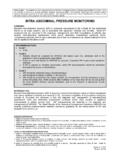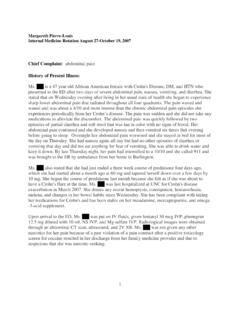Transcription of Waist Circumference and Waist-Hip Ratio
1 Waist Circumference and Waist -Hip Ratio Report of a WHO Expert Consultation GENEVA, 8 11 DECEMBER 2008. Waist Circumference and Waist Hip Ratio : Report of a WHO Expert Consultation Geneva, 8 11 December 2008. WHO Library Cataloguing-in-Publication Data Waist Circumference and Waist hip Ratio : report of a WHO expert consultation, Geneva, 8 11. December 2008. mass index. constitution. composition. Health Organization. ISBN 978 92 4 150149 1 (NLM classification: QU 100). World Health Organization 2011. All rights reserved. Publications of the World Health Organization are available on the WHO web site ( ) or can be purchased from WHO Press, World Health Organization, 20 Avenue Appia, 1211 Geneva 27, Switzerland (tel.: +41 22 791 3264; fax: +41 22 791 4857; e-mail: Requests for permission to reproduce or translate WHO publications whether for sale or for noncommercial distribution should be addressed to WHO Press through the WHO web site ( ).)
2 The designations employed and the presentation of the material in this publication do not imply the expression of any opinion whatsoever on the part of the World Health Organization concerning the legal status of any country, territory, city or area or of its authorities, or concerning the delimitation of its frontiers or boundaries. Dotted lines on maps represent approximate border lines for which there may not yet be full agreement. The mention of specific companies or of certain manufacturers' products does not imply that they are endorsed or recommended by the World Health Organization in preference to others of a similar nature that are not mentioned. Errors and omissions excepted, the names of proprietary products are distinguished by initial capital letters.
3 All reasonable precautions have been taken by the World Health Organization to verify the information contained in this publication. However, the published material is being distributed without warranty of any kind, either expressed or implied. The responsibility for the interpretation and use of the material lies with the reader. In no event shall the World Health Organization be liable for damages arising from its use. Printed by the WHO Document Production Services, Geneva, Switzerland. ii A c k n o w l e d g e m e n ts This meeting report was originally prepared by Dr Prakash Shetty, with support from Professor Shiriki Kumanyika (Chairperson of the consultation) and Dr Gary Tin Choi Ko (Rapporteur of the consultation). It was further developed and finalized with substantial support and inputs from Professor Shiriki Kumanyika, Professor Scott Lear, Professor Thorkild S rensen and Professor Paul Zimmet, and the members of the WHO Secretariat (Dr Chizuru Nishida and Dr Francesco Branca).
4 Special acknowledgement is made to all the members of the expert consultation, in particular to those who prepared the background papers for the consultation. WHO is grateful to the European Journal of Clinical Nutrition for accepting and publishing these background papers (EJCN, vol 64, No. 1, pp 2 61, January 2010) for wider dissemination. Acknowledgement is also made to the WHO staff from the departments of Nutrition for Health and Development, and Chronic Diseases and Health Promotion, who provided valuable contributions to the consultation. WHO expresses deep appreciation to the Ministry of Health, Labour and Welfare of the Government of Japan for their financial support for the commissioning of the background papers, holding of the expert consultation and production of the meeting report.
5 Technical editing of the report was undertaken by Dr Hilary Cadman from Cadman Editing Services in Australia and cover design was undertaken by Ms Sue Hobbs from Minimum Graphics in New Zealand. iii Abbreviations and acronyms ATP Adult Treatment Panel AUC area under the receiver operating characteristic curve BMI body mass index CARDIA Coronary Artery Risk Development in Young Adults CVD cardiovascular disease DEXA dual X ray absorptiometry FAO Food and Agriculture Organization of the United Nations FPR false positive rate IDF International Diabetes Federation MESA Multi Ethnic Study of Atherosclerosis NCD noncommunicable disease NCEP National Cholesterol Education Program NHANES National Health and Nutrition Examination Survey NHLBI National Heart, Lung and Blood Institute NIH National Institutes of Health ROC receiver operating characteristic STEPS STEP wise Approach to Surveillance (WHO).
6 SWAN Study of Women's Health Across the Nation TPR true positive rate US United States WHO World Health Organization iv C o n t e n ts iii Abbreviations and iv 1 1. 2 Methods for measuring Waist and hip 5. Placement, tightness and type of measuring tape ..5. Placement of tape ..5. Tightness and type of Subject posture and other factors ..6. Posture of the subjects during the measurement ..6. Phase of respiration at the exact point of measurement ..6. abdominal tension at the point of measurement ..6. Influence of stomach contents at time of measurement ..6. Measurement Implications of differences in methodology ..7. Summary and 3 Impact of variations in body fat distribution by sex, age and ethnicity .. 8. Sex ..8. Reproductive status ..8. Age.
7 9. Ethnic groups for which Waist Circumference or Waist hip Ratio may reflect more body fat at a given body mass index level ..10. Populations for which Waist Circumference or Waist hip Ratio may reflect less body fat at a given body mass index level ..10. Summary and 4 Relationships of Waist Circumference and Waist hip Ratio to disease risk and 12. Measures of obesity and abdominal obesity and cardiovascular disease risk ..12. Measures of obesity, abdominal obesity and type 2 diabetes v Measures of obesity and abdominal obesity and all cause mortality and mortality from specific causes ..14. Ethnic Summary and Cardiovascular Diabetes ..16. Risk factors ..16. Mortality ..16. Ethnic 5 Summary and 19. Usefulness of Waist Circumference and Waist hip Ratio for prediction of disease risk.
8 19. Measurement protocol ..20. Selecting cut off points ..21. Universal or population specific cut off 6 24. Annex A: Current uses of Waist circumferences and Waist hip ratios, and recommended cut off points .. 27. Annex B: List of 32. References .. 34. vi 1 Introduction The World Health Organization (WHO) Expert Consultation on Waist Circumference and Waist Hip Ratio was held in Geneva, Switzerland on 8 11 December 2008. The consultation was organized by WHO's Department of Nutrition for Health and Development, in collaboration with the Department of Chronic Diseases and Health Promotion. It was opened by Dr Ala Alwan, WHO Assistant Director General for Noncommunicable Diseases and Mental Health. The consultation was convened as part of WHO's: efforts in implementing the recommendations made at the WHO Consultation on Appropriate Body Mass Index for Asian Populations (WHO, 2004).
9 Response to the emerging problem of obesity and related chronic diseases, in particular in low and middle income countries. The 1997 WHO Expert Consultation on Obesity recognized the importance of abdominal fat mass (referred to as abdominal , central or visceral obesity), which can vary considerably within a narrow range of total body fat and body mass index (BMI). It also highlighted the need for other indicators to complement the measurement of BMI, to identify individuals at increased risk of obesity related morbidity due to accumulation of abdominal fat (WHO, 2000a). Waist hip Ratio ( the Waist Circumference divided by the hip Circumference ) was suggested as an additional measure of body fat distribution. The Ratio can be measured more precisely than skin folds, and it provides an index of both subcutaneous and intra.
10 abdominal adipose tissue (Bjorntorp, 1987). The suggestion for the use of proxy anthropometric indicators arose from a 12 year follow up of middle aged men, which showed that abdominal obesity (measured as Waist hip Ratio ) was associated with an increased risk of myocardial infarction, stroke and premature death, whereas these diseases were not associated with measures of generalized obesity such as BMI (Larsson et al., 1984). In women, BMI was associated with increased risk of these diseases; however, Waist hip Ratio appeared to be a stronger independent risk factor than BMI (Lapidus et al., 1984). The 2002 WHO Expert Consultation on Appropriate Body Mass Index for Asian Populations and Its Implications for Policy and Intervention Strategies (WHO, 2004) reviewed the issue of ethnic differences in the meaning of BMI cut off values.













